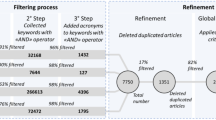This paper addresses the feature sequencing problem in the Rapid Design System (RDS). The RDS is a feature-based design system that integrates product design and process planning. An important issue in feature-based process planning for machined parts is the order in which material is removed to form the resultant part. The order, or sequence, is partially dependent on the geometric relationships between features. The sequence affects the safety, the time it takes to machine the part, and the quality of the finished part. The sequence of material removal depends on two types of relations between features: (1) intersections and (2) interfeature associations. Both types of relations compound the search for an ‘optimal’ sequence of material removal. Therefore, the research problem has been the discovery and development of a genetic algorithm (GA) that efficiently searches the solution space for all possible sequences and identifies the best sequences in terms of safety, time and quality.
Similar content being viewed by others
References
Chang, T. C. (1990)Expert Process Planning for Manufacturing, Addison-Wesley, Reading, MA.
Chen, C. L. P. and LeClair, S. R. (1994) An integration of design and manufacturing: solving setup generation and feature sequencing using an unsupervised learning approach.Computer Aided Design,26 (1).
Davis, L. and Steenstrup, A. (1987)Genetic Algorithms and Simulated Annealing, Morgan-Kaufmann, San Mateo, CA, pp. 4–11.
Goldberg, E. D. (1989)Genetic Algorithms in Search, Optimization, and Machine Learning, Addison-Wesley, Reading, MA.
Hayes, C. (1990) Machining planning: a model of an expert level planning process, PhD Dissertation, Carnegie-Mellon University.
LeClair, S. R. (1991) The Rapid Design System: memory-driven feature-based design, inProceedings of the 1991 IEEE Conference of Systems Engineering, Dayton, OH, August.
Lester, I. (1993) Simulated annealing: practice versus theory.Statistics and Computing.
Pao, Y. H. (1989)Adaptive Pattern Recognition and Neural Networks, Addison-Wesley, Reading, MA.
Westhoven, T. E., Chen, C. L. P., LeClair, S. R. and Pao, Y.-H. (1991) Episodal associative memory approach for sequencing interactive features in process planning.Artificial Intelligence in Engineering, Design Analysis, and Manufacturing (AIEDAM),6(4), 177–197.
Whitley, D. (1988) GENITOR: a different genetic algorithm, inProceedings of the Rocky Mountain Conference on Artificial Intelligence, Denver, CO.
Author information
Authors and Affiliations
Rights and permissions
About this article
Cite this article
Kamhawi, H.N., Leclair, S.R. & Chen, C.L.P. Feature sequencing in the rapid design system using a genetic algorithm. J Intell Manuf 7, 55–67 (1996). https://doi.org/10.1007/BF00114138
Issue Date:
DOI: https://doi.org/10.1007/BF00114138




